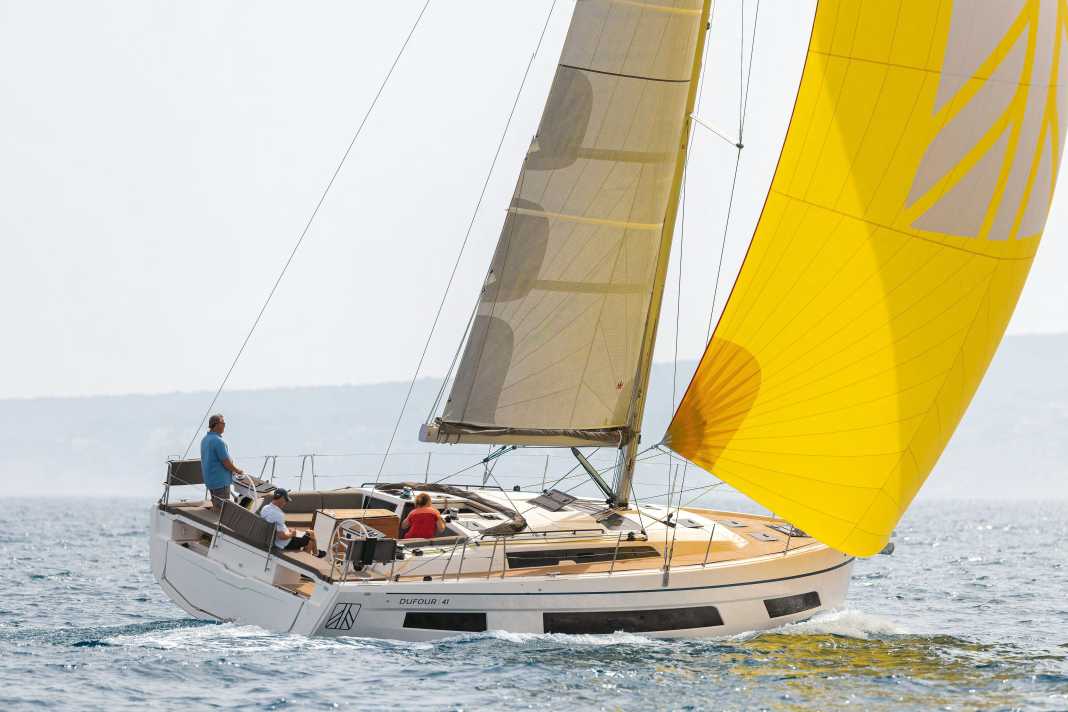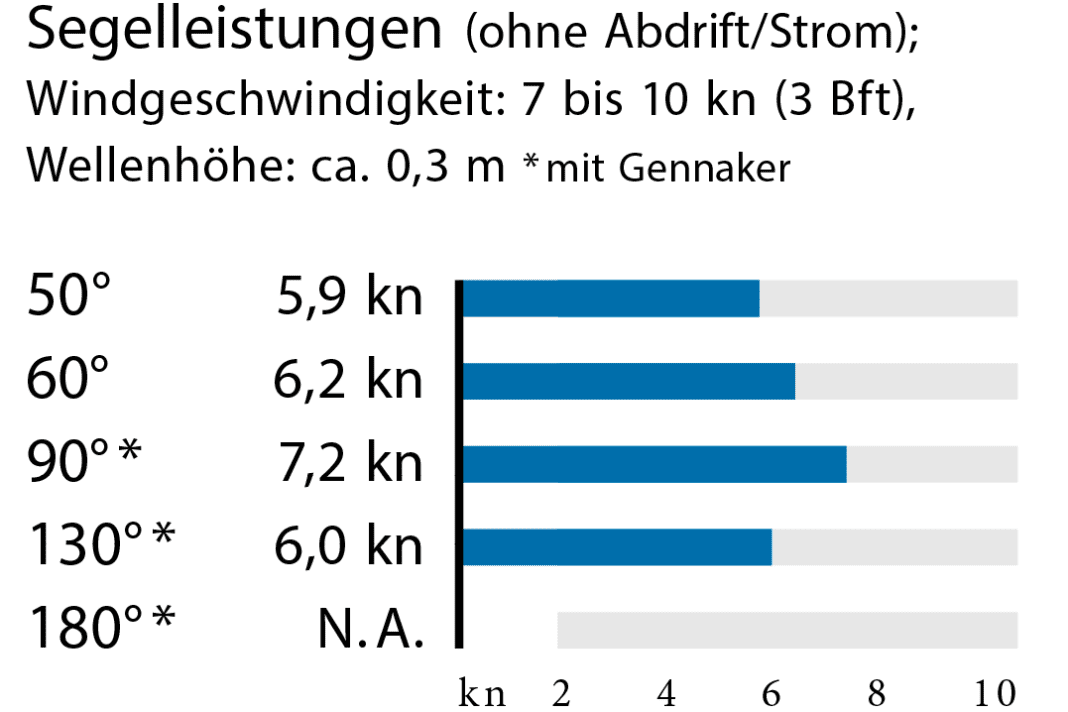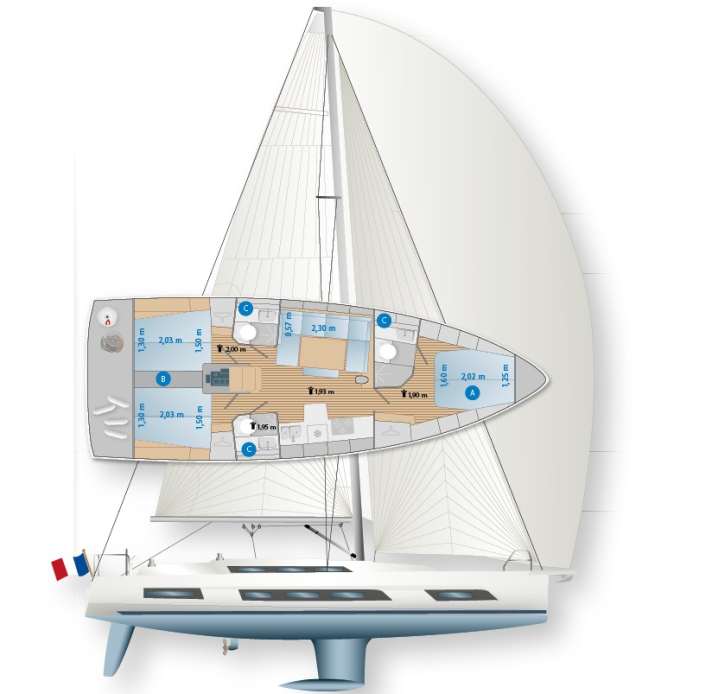





There were times when large series yachts could hardly be distinguished from one another. Length to width ratio, freeboard height, bow design, bulkhead shape, cockpit, rigging and fittings were all similar to identical. At most, experienced observers could identify the manufacturer by the window line or nuances in the stern. That is now a thing of the past.
Designers and shipyards are daring again. Manufacturers are varying the hull lines significantly, the sterns are becoming steeper to negative, the transoms are kinked, straight, half-open or closed by a flap. And the chine, that chine edge that sometimes makes GRP boats look like bent spars, serves as a highly welcome design feature in multiple forms. The chine can be sharp or soft, high, deep, descending or ascending, running all the way to the bow or ending gently somewhere in front of it. The chine is not just a design feature: the kink can make the hull stiffer and provide dimensional stability. It also creates space in the hull and in the cabins, particularly in the stern.
The chine makes it possible to combine a narrow waterline for a smaller wetted area with a vertical freeboard above and a large hull width. A trick that is often used in the centre hulls of trimarans, which are very narrow but need more volume for living.
Dufour 41: Volume trend continues
This issue is particularly important in the aft cabins. There should be two of them if possible, and in order to make the berths large enough, the absolute width must also play a role in addition to the shape of the bulkhead. And so it goes on: The wide stern area will tip the boat on its nose when heeling, so volume is also needed at the front. The full foredeck counteracts the trim, which in turn creates more volume in the bow area for a wide berth and plenty of space. This makes modern cruising boats look more and more like current regatta yachts such as the Class 40, which look like an ironing board when viewed from above: A rounded bow and a constant width aft - the observer is almost reminded of a motorboat. What gives the racer high stability and good gliding properties creates volume and therefore comfort for the cruiser.
The shipyards are pushing this point to the limit with their latest designs. They use chines to maximise volume and also use beading and edges to give the boat a distinctive look. These are all features that can be utilised to great effect for differentiation.
This is also the case at Dufour. The shipyard, which has been in second place in the size ranking of shipyards behind the Beneteau Group since the takeover by catamaran giant Fountaine Pajot, is focussing extremely on volume and a very progressive design with its new models. With the 32, the 37 and now the 41.
Maximising the living space on deck was a requirement for the new boat. It has been consistently realised. The cockpit offers space for more people than there are berths on board
The chine runs almost continuously horizontally, and quite far down. Above this follows a slightly concave section of the freeboard with hull windows in a dark area, which makes them appear even more powerful. Above this is another kink. The bow is bevelled aft at the top, with a fixed GRP bowsprit above it. The windows in the flat superstructure and those in the hull are trapezoidal. The forecastle is full and round. The greatest width is 4.30 metres, and the hull is barely narrower at the stern.
Designer Umberto Felci: "The hull shape is intended to increase stability and volume without compromising the sailing characteristics." Does this work in combination with more mass and more resistance?
Test in Palma, Germany's favourite island, where charter company and Dufour dealer Yates Mallorca has taken delivery of build number one. On site, the large cockpit is particularly striking, a realisation of the shipyard's requirement for more space and living space, which also sensibly includes the outside area. Felci again: "The new proportions between the cockpit and the superstructure as well as the new style form the synthesis of all the functions that are indispensable in a new yacht today."
The large cockpit of the Dufour 41 is no obstacle
In concrete terms: the dents are already 1.80 metres long, plus a transverse bench aft that can be opened with two flaps and is a full 3.30 metres long. This integrates the space behind the wheels into the rest of the cockpit.
Under sail, the huge cockpit is not a hindrance. The table is large, but still allows good freedom of movement. There is plenty of room to stand and sit behind the steering wheels, even with several people. The wheels are rather small with a diameter of 80 centimetres, and from stop to stop it is just under two turns, but the system still works directly enough.
In the wind range below ten knots, which is critical for most cruising yachts, the Dufour manages between 5.5 and 5.9 knots, which are very decent values, especially as these can also be achieved in slightly choppy waves. The height is not yet famous at around 50 degrees downwind, but overall the boat proves to be quite agile.
The deck layout of the Dufour 41 is available in three versions
Rudder pressure only sets in from just under ten knots of wind, and then the speed also increases to up to 6.5 knots at the cross. With even more pressure and under gennaker on sharp courses, the Dufour also proves to be stiff and very easy to control, even in higher conditions.
It should be possible to achieve a better height with a quickly adjustable backstay tensioner in the form of a tackle or a hydraulic cylinder, which is an option. The shipyard offers three versions of the deck layout: "Easy" centralises the mainsheet, which is attached via a cockpit, and the standard self-tacking jib on the coachroof. This means that the line rigging is out of the guest area, but also out of reach of the helmsman. "Ocean" is fitted with two additional winches on the coaming. This is where the sheets of the optional genoa and the mainsheet on both sides are led. This gives the helmsman full control and allows him to help with manoeuvres or carry them out completely on his own and trim the sails at any time. The solution for small crews.
The "Performance" version runs the mainsheet in the cockpit, comes with a textile backstay, higher-quality running rigging and also the genoa rails including some decorative elements such as a black mast.
A total of 32 hatches, windows and panes in the hull, superstructure and cockpit ensure maximum light in all rooms
What is generally missing are footrests, preferably in the form of large surfaces that can be folded out of the floor. And an angled, flat raised seat on deck for the helmsman would be useful so that he doesn't have to sit straight upwind and with water on deck directly in the wet.
What is also noticeable on board, but only becomes apparent inside, are the many windows and hatches. There are 32 of them. They let a lot of light into the ship and increase the feeling of space. In the aft cabins in particular, you almost feel like you're on a catamaran. With a length of 3.10 metres, the saloon is quite short, thanks to the large cockpit and a spacious forward cabin. There is no navigation corner, so anyone still working with paper nautical charts will have to use the 75 x 120 centimetre saloon table.
The galley is orientated lengthways and has a special feature: The standard large refrigerator and the work surface above it protrude into the room, with the oven hob and sink to the left and right of it, making it ideal for two people to work in the galley at the same time.
Dufour 41: How the cruising yacht is made
The two bathrooms also take up space in the saloon. The rooms are included in every version and are either both converted into a bathroom or one as a toilet and the other as a shower or storage space. A third bathroom is realised at the front, unless the owner wishes to have two cabins there, which the spacious bow area allows. Three or four cabins and one, two or three bathrooms are therefore possible.
For the surfaces, the customer can choose between real wood veneers in light-coloured oak (test ship) or darker teak.
The hull is manufactured in a vacuum infusion process as a sandwich with a foam core using vinyl ester resin, which is considered osmosis-resistant. The deck is produced using the RTM process (Resin Transfer Moulding) in a closed mould, also under vacuum. This production method produces smooth, clean surfaces on both sides. This means that no ceiling panelling is required. But: cap nuts and washers of bolted-through fittings are visible and ceiling lights require an additional mounting surface, which may have ensured that the number of ceiling spots on the boat is sometimes quite low (forward cabin) to non-existent (aft cabin).
Price: This is how much the new Dufour 41 costs
A high level of comfort, good sailing characteristics, high-quality construction - that costs: the basic price is 273,700 euros. The shipyard's comfort package, which includes things like a boiler, anchor winch and shore connection, adds 17,850 euros to the bill. The boat is only available with this package.
That makes 291,550 euros, which is currently between six and twelve per cent more than the competition is charging. A reasonable delta for customers looking for a good boat with plenty of space.
The measured values for the test of the Dufour 41





The Dufour 41 in detail

Technical data
- Design engineer: Umberto Felci
- Design: Lucas Ardizio
- CE design category: A
- Torso length: 11,99 m
- Total length: 12,75 m
- Waterline length: 11,20 m
- Width: 4,30 m
- Draught/alternative: 2,10/1,75 m
- Mast height above WL: 19,00 m
- Theor. torso speed: 8.0 kn
- Weight: 9,7 t
- Ballast/proportion: 2,7 t/28 %
- Mainsail: 34,5 m²
- Self-tacking jib (Std.): 40,0 m²
- Engine (Volvo):37 kW/50 hp
- Fuel tank: 250 l
- Fresh water tank: 430 l
- Holding tank: 40 l
Equipment and prices*
- Base price ex shipyard: €273,700
- Price ready to sail: € 281,232
- Warranty/against osmosis: 2/5 years
Prices as of 07/2023, as the prices shown are defined, you will find here !
Hull and deck construction
Hull vacuum infusion process, deck RTM infusion, joint glued, screwed and partially laminated. Vinyl ester resin
Hull lines
The hull is extremely wide, even aft. The foredeck has been voluminously designed for more buoyancy and space
Rudder
Despite the wide stern, the shipyard and designer have dispensed with a twin rudder system. In the test, the boat coped well with a fin
Deck layouts
Depending on the version, the sheets are operated on the roof or in front of the wheels. A cockpit traveller is possible.
Cockpit
The wide and long cockpit offers living space for the full crew and guests. A barbecue is installed in the bench
Variants below deck
Two, three or even four cabins and up to three heads are possible. Thanks to the large hull volume, the berths are wide enough. With eight people, however, it gets cramped, at least in the saloon
Storage space
The two forecastle boxes are quite tight, but there is still plenty of space under the aft cockpit floor
Cooling volume
Refrigerator 200 l, freezer n. a.
Windows and hatches
14 horizontal hatches and windows in the deck and 21(!) vertical ones in the superstructure, cockpit and hull provide more light and air than on any other boat of this size
Tailgate
With a length of 2.80 metres and a width of 0.70 metres, the manually operated bathing platform is not yet a standard size, but it is perfectly adequate and easy to use thanks to an automatic step and a bathing ladder with horns
Life raft
The raft has its own compartment in the mirror. However, the tailgate must be opened in order to use it
Shipyard
- Dufour Yachts
- 17180 Perigny/ France
- info@dufour-yachts.com
- www.dufour-yachts.com
Distribution
Dealer network
YACHT rating
The strikingly modern design of the Dufour 41 fulfils the shipyard's objectives of optimised comfort and living space on and below deck. The sailing characteristics have not suffered as a result. Good layout options inside and out. The price is reasonable.
Design and concept
- + Independent modern
- + Style Very large volume
- + Sensible layout variance
- + Huge cockpit
- - Slightly more expensive than the competition
Living and finishing quality
- + Successful room layout
- + Many and large windows
- - Lighting in aft cabins
Sailing performance and trim
- + Great potential
- + High stability
- + Deck layout (Vers. Ocean)
- - A little tough under 10 knots
Equipment and technology
- + High-quality construction
- + Customisable deck layout
- + Large winches
- + Easily accessible installations

